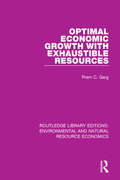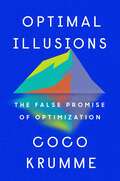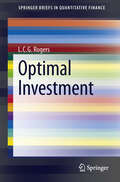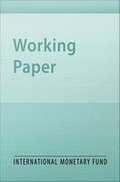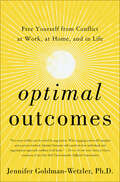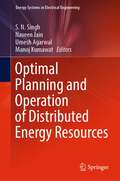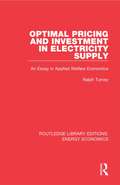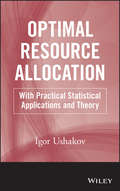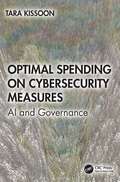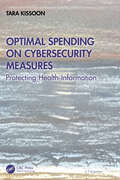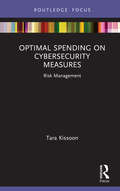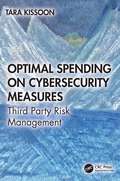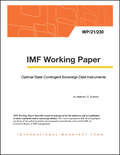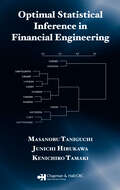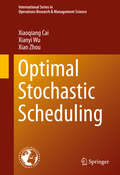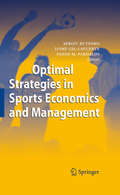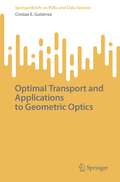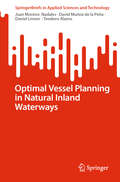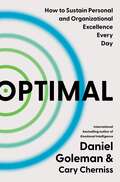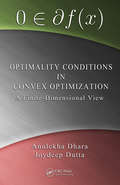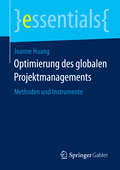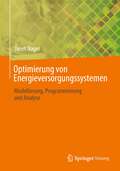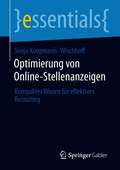- Table View
- List View
Optimal Economic Growth with Exhaustible Resources (Routledge Library Editions: Environmental and Natural Resource Economics)
by Prem C. GargOriginally published in 1979. For decades conservationists have argued that increasing population will eventually out-strip the limited natural resources of the earth. Economists have responded by saying that any resource scarcity will be forestalled by changes in tastes and technology, induced by the appropriate price signals. This study is an attempt to develop a theoretical framework for analysing some of the issues related to this debate. Using an optimal growth theory framework, the author analyses the problem of optimally allocating a finite stock of the resource over time. In the process the author points out the crucial parameters and value judgments relevant to the various issues. This title will be of interest to students of environmental economics.
Optimal Illusions: The False Promise of Optimization
by Coco KrummeHow optimization took over the world and the urgent case for a new approach Optimization is the driving principle of our modern world. We now can manufacture, transport, and organize things more cheaply and faster than ever. Optimized models underlie everything from airline schedules to dating site matches. We strive for efficiency in our daily lives, obsessed with productivity and optimal performance. How did a mathematical concept take on such outsize cultural shape? And what is lost when efficiency is gained?Optimal Illusions traces the fascinating history of optimization from its roots in America&’s founding principles to its modern manifestations, found in colorful stories of oil tycoons, wildlife ecologists, Silicon Valley technologists, lifestyle gurus, sugar beet farmers, and poker players. Optimization is now deeply embedded in the technologies and assumptions that have come to comprise not only our material reality but what we make of it.Coco Krumme&’s work in mathematical modeling has made her acutely aware of optimization&’s overreach. Streamlined systems are less resilient and more at risk of failure. They limit our options and narrow our perspectives. The malaise of living in an optimized society can feel profoundly inhumane. Optimal Illusions exposes the sizable bargains we have made in the name of optimization and asks us to consider what comes next.
Optimal Investment
by L. C. RogersReaders of this book will learn how to solve a wide range of optimal investment problems arising in finance and economics. Starting from the fundamental Merton problem, many variants are presented and solved, often using numerical techniques that the book also covers. The final chapter assesses the relevance of many of the models in common use when applied to data.
Optimal Monetary Policy with Overlapping Generations of Policymakers
by Maral ShamlooA report from the International Monetary Fund.
Optimal Monetary and Fiscal Policy with Limited Asset Market Participation
by Sven Jari StehnA report from the International Monetary Fund.
Optimal Outcomes: Free Yourself from Conflict at Work, at Home, and in Life
by Jennifer Goldman-Wetzler“This hands-on book is full of reflection exercises to help you spot the hidden patterns in your regular clashes and learn how to defuse them.” —Adam Grant, #1 New York Times–bestselling author A founding CEO and his top salesperson are engaged in a heated clash over her compensation package.A mother and daughter are locked in a nasty cycle of blame and attack.A high-profile executive team is struggling with aggressive political infighting.In all these cases, every effort to talk it out has been unsuccessful.Where can you turn when your attempts to resolve conflict fail? Most approaches emphasize collaboration. You are supposed to sit down, calmly talk through your differences, and find a solution. But what if nothing seems to work, no matter what you do?When situations resist resolution, the Optimal Outcomes Method teaches us conflict freedom.This innovative method is based on Dr. Jennifer Goldman-Wetzler’s training at the Program on Negotiation at Harvard Law School, two decades as a consultant to Fortune 500 and high-growth CEOs and senior teams, grassroots work with Middle East leaders, US government-funded research on terrorism, and her popular course at Columbia University. In Optimal Outcomes, she reveals eight groundbreaking practices proven to help people everywhere free themselves from conflict.With inspiring stories from clients, students, and Dr. Goldman-Wetzler’s own life lighting the way, you’ll learn to observe complex situations with clarity, access your shadow values (things you really care about but have been unwilling to admit), and take bold, simple, surprising action. Applying the practices, you’ll reach your Optimal Outcome—which may be vastly different from what you originally imagined, but more satisfying than you ever dreamed possible.
Optimal Planning and Operation of Distributed Energy Resources (Energy Systems in Electrical Engineering)
by Naveen Jain S. N. Singh Umesh Agarwal Manoj KumawatThe book deals with integrated distributed energy resources in existing power systems optimally to mitigate power quality issues in power systems. The book is designed for research using modern optimization techniques and a thorough analysis of renewable energy. The book provides an in-depth study of recent trends of research scope around the globe and also includes modern heuristic approaches, hands-on data, and case studies of all important dimensions of distributed energy resources. It addresses key issues such as the integration of DERs and electric vehicles, optimization algorithms, management of DERs with electric vehicles, energy pool management mechanisms, protection, and reliability in the restructured power system. This book will be useful for students, research scholars, practitioners, and academicians.
Optimal Pricing and Investment in Electricity Supply: An Esay in Applied Welfare Economics (Routledge Library Editions: Energy Economics)
by Ralph TurveyOriginally published in 1968, this book was one of the first full-scale published studies of the principles of investment planning and of the structure of marginal costs in a public enterprise. The concepts involved were more developed and applied in the world's electricity industries than elsewhere, and this book will be of interest to both engineers and administrators who are concerned with electricity supply, by setting out the characteristics of investment planning in this sector and the implications for cost analysis.
Optimal Resource Allocation
by Igor A. UshakovA UNIQUE ENGINEERING AND STATISTICAL APPROACH TO OPTIMAL RESOURCE ALLOCATIONOptimal Resource Allocation: With Practical Statistical Applications and Theory features the application of probabilistic and statistical methods used in reliability engineering during the different phases of life cycles of technical systems.Bridging the gap between reliability engineering and applied mathematics, the book outlines different approaches to optimal resource allocation and various applications of models and algorithms for solving real-world problems. In addition, the fundamental background on optimization theory and various illustrative numerical examples are provided. The book also features:An overview of various approaches to optimal resource allocation, from classical Lagrange methods to modern algorithms based on ideas of evolution in biologyNumerous exercises and case studies from a variety of areas, including communications, transportation, energy transmission, and counterterrorism protectionThe applied methods of optimization with various methods of optimal redundancy problem solutions as well as the numerical examples and statistical methods needed to solve the problemsPractical thoughts, opinions, and judgments on real-world applications of reliability theory and solves practical problems using mathematical models and algorithmsOptimal Resource Allocation is a must-have guide for electrical, mechanical, and reliability engineers dealing with engineering design and optimal reliability problems. In addition, the book is excellent for graduate and PhD-level courses in reliability theory and optimization.
Optimal Spending on Cybersecurity Measures: AI and Governance
by Tara KissoonThe aim of this book is to demonstrate the use of business‑driven risk assessments to address government regulations and guidelines specific to AI risks, as AI systems often require access to personal data. All aspects of AI, machine learning models, continuous learning, generalization, and predictive and descriptive analytics are dependent on massive datasets. The more diverse and comprehensive the data, the better an AI can perform. Therefore, AI systems require vast amounts of personal data, and should this data be accessed by unauthorized individuals or organizations, it will lead to a privacy breach, which may result in personal harm to citizens, i.e., identity theft.This book introduces the cyber risk investment model and the cybersecurity risk management framework used within business‑driven risk assessments to address government regulations, industry standards, and applicable laws. It can be used by various stakeholders who are involved in the implementation of cybersecurity measures to safeguard sensitive data. This framework facilitates an organization’s risk management decision‑making process to demonstrate the mechanisms in place to fund cybersecurity measures and demonstrates the application of the process by showcasing two case studies.Features: Aims to strengthen the reader’s understanding of industry governance, AI risk, and compliance practices. Incorporates an innovative approach to assess business risk management specific to AI systems. Explores the strategic decisions made by organizations when implementing cybersecurity measures and leverages an integrated approach to include risk management elements.
Optimal Spending on Cybersecurity Measures: Protecting Health Information
by Tara KissoonThe aim of this book is to demonstrate the use of business-driven risk assessments within the privacy impact assessment process to meet the requirements of privacy laws.This book introduces the cyber risk investment model, and the cybersecurity risk management framework used within business-driven risk assessments to meet the intent of Privacy and Data Protection Laws. These can be used by various stakeholders who are involved in the implementation of cybersecurity measures to safeguard sensitive data. This framework facilitates an organization’s risk management decision-making process to demonstrate the mechanisms in place to fund cybersecurity measures to comply with Privacy Laws and demonstrates the application of the process by showcasing six case studies. This book also discusses the elements used within the cybersecurity risk management process and defines a strategic approach to minimize cybersecurity risks.Features: Aims to strengthen the reader’s understanding of industry governance, risk and compliance practices. Incorporates an innovative approach to assess business risk management. Explores the strategic decisions made by organizations when implementing cybersecurity measures and leverages an integrated approach to include risk management elements.
Optimal Spending on Cybersecurity Measures: Risk Management (Routledge Focus on Business and Management)
by Tara KissoonThis book explores the strategic decisions made by organizations when implementing cybersecurity controls and leveraging economic models and theories from the economics of information security and risk-management frameworks. Based on unique and distinct research completed within the field of risk-management and information security, this book provides insight into organizational risk management processes utilized in determining cybersecurity investments. It describes how theoretical models and frameworks rely on either specific scenarios or controlled conditions and how decisions on cybersecurity spending within organizations, specifically the funding available in comparison to the recommended security measures necessary for compliance, vary depending on stakeholders. As the trade-off between the costs of implementing a security measure and the benefit derived from the implementation of security controls is not easily measured, a business leader’s decision to fund security measures may be biased. The author presents an innovative approach to assess cyber security initiatives with a risk-management perspective and leverages a data-centric focus on the evolution of cyber-attacks. This book is ideal for business school students and technology professionals with an interest in risk management.
Optimal Spending on Cybersecurity Measures: Third Party Risk Management
by Tara KissoonThis book aims to demonstrate the use of business‑driven risk assessments to address government regulations and guidelines specific to the management of risks related to all third‑party arrangements and emphasises that organisations retain accountability for business activities, functions and services outsourced to a third party.This book introduces the cyber risk investment model and the cybersecurity risk management framework used within business‑driven risk assessments to address government regulations, industry standards and applicable laws. This can be used by various stakeholders who are involved in the implementation of cybersecurity measures to safeguard sensitive data. This framework facilitates an organisation’s risk management decision‑making process to demonstrate the mechanisms in place to fund cybersecurity measures and demonstrates the application of the process showcasing three case studies. This book also discusses the elements used within the cybersecurity risk management process and defines a strategic approach to minimise cybersecurity risks.Features: Aims to strengthen the reader’s understanding of industry governance, risk and compliance practices. Incorporates an innovative approach to assess business risk management. Explores the strategic decisions made by organisations when implementing cybersecurity measures and leverages an integrated approach to include risk management elements.
Optimal State Contingent Sovereign Debt Instruments (Imf Working Papers)
by Alejandro D. GuersonA report from the International Monetary Fund.
Optimal Statistical Inference in Financial Engineering
by Masanobu Taniguchi Junichi Hirukawa Kenichiro TamakiUntil now, few systematic studies of optimal statistical inference for stochastic processes had existed in the financial engineering literature, even though this idea is fundamental to the field. Balancing statistical theory with data analysis, Optimal Statistical Inference in Financial Engineering examines how stochastic models can effectively des
Optimal Stochastic Scheduling
by Xiaoqiang Cai Xianyi Wu Xian ZhouMany interesting and important results on stochastic scheduling problems have been developed in recent years, with the aid of probability theory. This book provides a comprehensive and unified coverage of studies in stochastic scheduling. The objective is two-fold: (i) to summarize the elementary models and results in stochastic scheduling, so as to offer an entry-level reading material for students to learn and understand the fundamentals of this area and (ii) to include in details the latest developments and research topics on stochastic scheduling, so as to provide a useful reference for researchers and practitioners in this area. Optimal Stochastic Scheduling is organized into two parts: Chapters 1-4 cover fundamental models and results, whereas Chapters 5-10 elaborate on more advanced topics. More specifically, Chapter 1 provides the relevant basic theory of probability and then introduces the basic concepts and notation of stochastic scheduling. In Chapters 2 and 3, the authors review well-established models and scheduling policies, under regular and irregular performance measures, respectively. Chapter 4 describes models with stochastic machine breakdowns. Chapters 5 and 6 introduce, respectively, the optimal stopping problems and the multi-armed bandit processes, which are necessary for studies of more advanced subjects in subsequent chapters. Chapter 7 is focused on optimal dynamic policies, which allow adjustments of policies based on up-to-date information. Chapter 8 describes stochastic scheduling with incomplete information in the sense that the probability distributions of random variables contain unknown parameters, which can however be estimated progressively according to updated information. Chapter 9 is devoted to the situation where the processing time of a job depends on the time when it is started. Lastly, in Chapter 10 the authors look at several recent models beyond those surveyed in the previous chapters.
Optimal Strategies in Sports Economics and Management
by Panos M. Pardalos Jaime Gil-Lafuente Sergiy ButenkoThis volume presents original contributions from renowned researchers in sports economics, management, and optimization.The book discusses up-to-date developments in several topics, including resource allocation strategies in sports industry, impact of the financial crisis on professional sports around the world, fairness in sports competitions, and optimization-based gambling strategies. "Optimal Strategies in Sports Economics and Management" will be of interest not only to students, researchers and practitioners involved with the sports industry, but also to the general public interested in sports such as soccer, hockey, American football, basketball, golf, and jai alai.
Optimal Transport and Applications to Geometric Optics (SpringerBriefs on PDEs and Data Science)
by Cristian E. GutiérrezThis book concerns the theory of optimal transport (OT) and its applications to solving problems in geometric optics. It is a self-contained presentation including a detailed analysis of the Monge problem, the Monge-Kantorovich problem, the transshipment problem, and the network flow problem. A chapter on Monge-Ampère measures is included containing also exercises. A detailed analysis of the Wasserstein metric is also carried out. For the applications to optics, the book describes the necessary background concerning light refraction, solving both far-field and near-field refraction problems, and indicates lines of current research in this area. Researchers in the fields of mathematical analysis, optimal transport, partial differential equations (PDEs), optimization, and optics will find this book valuable. It is also suitable for graduate students studying mathematics, physics, and engineering. The prerequisites for this book include a solid understanding of measure theory and integration, as well as basic knowledge of functional analysis.
Optimal Vessel Planning in Natural Inland Waterways (SpringerBriefs in Applied Sciences and Technology)
by Teodoro Alamo David Muñoz de la Peña Daniel Limon Juan Moreno NadalesThis book is an essential guide to optimal and safe navigation planning in inland waterways. The book’s comprehensive coverage includes: In-depth coverage of optimal planning, safety measures and economic considerations. Practical tools including images, diagrams, and algorithms for actionable solutions. Optimization methods for optimal navigation planning. Algorithms for safe navigation. Instructions for implementing a monitoring system and incident detection algorithms for real-time dynamic re-planning in natural inland waterways. Mitigation strategies for uncertainties and reducing navigation risks through real-time rescheduling. A fresh perspective on the dynamic world of inland waterway transportation. A practical guide for implementing the proposed algorithms in open-source software tools and cloud architectures. The book is essential reading for professionals and academics in logistics and maritime transportation.
Optimal: How to Sustain Personal and Organizational Excellence Every Day
by Daniel Goleman Cary ChernissIn his groundbreaking #1 bestseller Emotional Intelligence, Daniel Goleman revolutionized how we think about intelligence. Now, he reveals practical methods for using these inner resources to more readily enter an optimal state of high performance and satisfaction while avoiding burnout. There are moments when we achieve peak performance: An athlete plays a perfect game; a business has a quarter with once-in-a-lifetime profits. But these moments are often elusive, and for every amazing day, we may have a hundred ordinary and even unsatisfying days. Fulfillment doesn’t come from isolated peak experiences, but rather from many consistent good days. So how do we sustain performance, while avoiding burnout and maintaining balance? In Optimal, Daniel Goleman and Cary Cherniss reveal how emotional intelligence can help us have a great day, any day. They explain how to set a realistic, attainable goal of feeling satisfied that you’ve had a productive day — to consistently work at your ‘optimal’ level. Based on research of how hundreds of people build the inner architecture of having a good day, they sketch what an optimal state feels like, and show how emotional intelligence holds the key to our best performance.Optimal is the culmination of decades of scientific discoveries bearing on emotional intelligence. Enhanced emotional intelligence pays off in improved engagement, productivity, and more satisfying days. In this book, you’ll find the keys to competence in emotional intelligence, and practical methods for applying this skill set more readily. It will equip you to become a highly effective leader and enable you to build an organizational culture that empowers workers to sustain high performance.
Optimality Conditions in Convex Optimization: A Finite-Dimensional View
by Joydeep Dutta Anulekha DharaOptimality Conditions in Convex Optimization explores an important and central issue in the field of convex optimization: optimality conditions. It brings together the most important and recent results in this area that have been scattered in the literature-notably in the area of convex analysis-essential in developing many of the important results
Optimally Irrational: The Good Reasons We Behave the Way We Do
by Lionel PageFor a long time, economists have assumed that we were cold, self-centred, rational decision makers – so-called Homo economicus; the last few decades have shattered this view. The world we live in and the situations we face are of course rich and complex, revealing puzzling aspects of our behaviour. Optimally Irrational argues that our improved understanding of human behaviour shows that apparent 'biases' are good solutions to practical problems – that many of the 'flaws' identified by behavioural economics are actually adaptive solutions. Page delivers an ambitious overview of the literature in behavioural economics and, through the exposition of these flaws and their meaning, presents a sort of unified theory of behaviouralism, cognitive psychology and evolutionary biology. He gathers theoretical and empirical evidence about the causes of behavioural 'biases' and proposes a big picture of what the discipline means for economics.
Optimierung des globalen Projektmanagements: Methoden und Instrumente (essentials)
by Joanne HuangIn diesem Essential lernt der Leser geeignete Führungsmethoden kennen, die den Anforderungen des globalen Projektmanagements (GPM) gerecht werden. Joanne Huang gibt Anregungen, wie Projektmanager adaquate Handlungsmoglichkeiten selbst entwickeln und die eigenen Management-Skills für Auslandsprojekte optimieren können. Die Hauptaufgabe beim Management globaler Projekte besteht darin, eine funktionierende Zusammenarbeit von multinationalen Teams aus verschiedenen Kulturkreisen zu bewirken sowie die Ressourcen des gesamten Projektumfelds optimal zu nutzen.
Optimierung von Energieversorgungssystemen: Modellierung, Programmierung und Analyse
by Janet NagelWie ein Modell zur Optimierung des Energieversorgungssystems in Deutschland umgesetzt werden kann, zeigt dieses Buch. Im Mittelpunkt steht das Programm Open Energy Modeling Framework (OEMOF) als Software zur Modellierung von Energieversorgungssystemen. Dessen einzelne Elemente sind beispielhaft beschrieben und ein Überblick über den Aufbau des Modells wird gegeben. Die technischen Komponenten von OEMOF sind anhand von mathematischen Berechnungen demonstriert, und sind zusammen mit ausreichend Python-Code präsentiert, um mit der grundlegenden Modellierung zu beginnen. Darüber erhält der Leser ein allgemeines Verständnis für die Umsetzung eines generischen Ansatzes zur Abbildung von Optimierungsproblemen im Energiesektor.Das Buch richtet sich an alle, die sich für Optimierungsmodelle für Energieversorgungssysteme oder für die mathematische Beschreibung der technischen Komponenten solcher Systeme in der praktischen Umsetzung am realen Beispiel von OEMOF interessieren. Thermodynamische Beschreibungen der Verbrennung werden bereitgestellt, so dass sich der Leser auf die Modellierungsaspekte konzentrieren kann. Auch für Forscher und Praktiker ist das Buch nützlich, da es ihr Wissen über die technischen Komponenten von Energieversorgungssystemen, unterstützt durch detaillierte mathematische Berechnungen, erweitert.
Optimierung von Online-Stellenanzeigen: Kompaktes Wissen für effektives Recruiting (essentials)
by Sonja Koopmann-WischhoffDieses Buch gibt einen kompakten Überblick zu der Gestaltung und Optimierung von Online-Stellenanzeigen. Personaler und Recruiter erfahren, wie sie Stellenanzeigen noch optimaler aufbauen und formulieren, um mit deren Hilfe vakante Positionen effektiv und schnell besetzen zu können. Gerade in Branchen mit einem Mangel an qualifizierten Fachkräften können Personaler durch eine präzise Stellenanzeige potenzielle Kandidaten ansprechen und auf ihr Unternehmen aufmerksam machen. Zahlreiche Beispiele und eine Checkliste mit den wichtigsten Optimierungskriterien ermöglichen eine schnelle Umsetzung in die Praxis.
